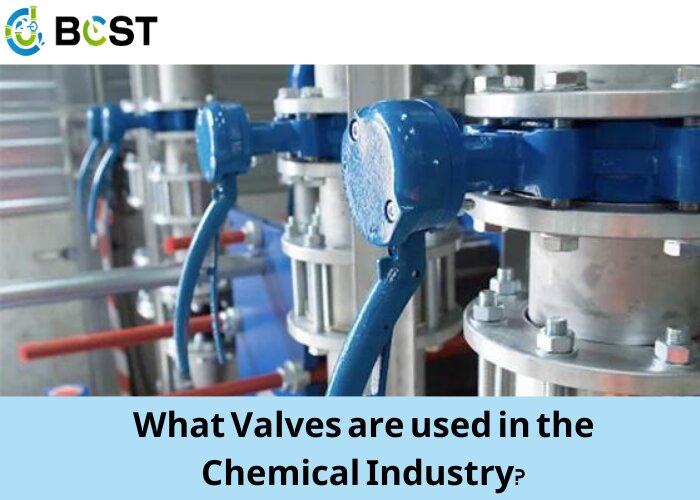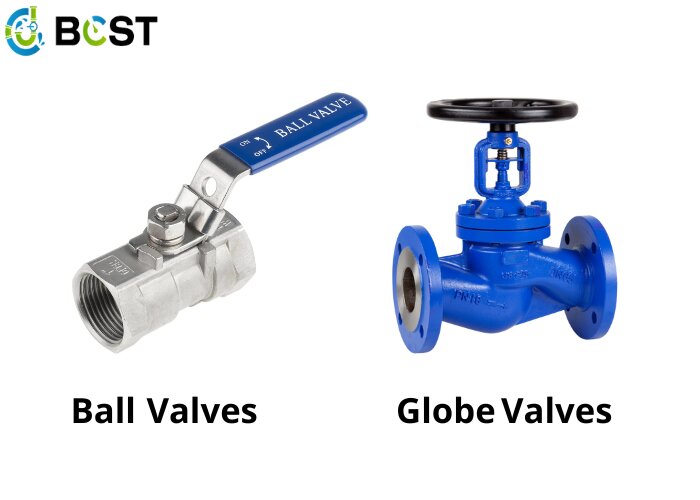
Valves are crucial in the chemical sector, serving multiple functions beyond precise control and dosing. Their responsibilities include pressure monitoring, safeguarding other equipment, and ensuring compatibility with the flow media. Consequently, valves need to be tailored for their intended purposes. This article delves into the prevalent types of valves utilized in the chemical industry, explores the importance of material compatibility with process media, and elucidates the functioning of chemical injection valves.
Common Valves in the Chemical Industry
A ball valve consists of a ball with a hole in the center that can be rotated to control flow and pressure on the valve. As a quarter-turn valve, only a 90° rotation is necessary to fully open or close the valve, delivering speed in actuation and making it easy to automate the process.
Ball valves are simple to use and maintain, with low flow resistance. Another aspect that makes these valves popular in the chemical sector is the air-tight seal they provide when closed. They stay leak-tight even after extended inactivity and effectively shut off caustic and aggressive fluids. The tight shutdown is appropriate for use in situations requiring great precision, such as gas distribution.
Like ball valves, globe valves also effectively regulate the flow of liquids and gases. In addition, they are highly reliable and can withstand high temperatures and pressures. The main advantage of using these valves is their precise flow regulation, although they remain effective in shut-off applications, too.
Because there are at least two changes in the flow direction across the valve, globe valves are associated with relatively high-pressure losses. Globe valves effectively control the flow of corrosive and abrasive chemical solutions, sticky slurries, and suspended solids. This is why they are common in pumps and other systems where throttling is needed.

Butterfly valves are appropriate for large-bore applications because they are lightweight and simple to install. They feature a simple design that consists of a disc that rotates on an axis perpendicular to flow to enable or obstruct it. As a result, they are quarter-turn valves that are great for throttling and are simple to automate. Furthermore, butterfly valves are appropriate for corrosive liquids at low temperatures and pressures. If adequate sealing is a significant concern, other valve types should be explored, particularly in the long run.
A gate valve has a disc that swings perpendicular to the flow to allow or prevent it. These valves typically only work in fully open or closed positions. Because of the impact of flow pressure on the gate/disc, a partial opening exposes internal components to wear.
Gate valves take up little space in the pipe axis and pose no obstacle to flow, resulting in minimum pressure loss across the valve. Gate valves are mostly used to segregate liquid flow in the chemical industry, though they can also be employed to some extent when the flow media is gas or solids.

Check valves are self-actuating, two-port valves that open and close in accordance with the flow velocity/pressure. The first port permits flow into the valve, while the second port allows flow out. As a result, they are always tailored to match unique flow needs.
They allow liquid or gas to flow in only one direction, preventing any backflow harm. Check valves are widely used in chemical pumps, compressors, and storage tanks due to their one-way flow function. In low-pressure gas applications, they also function as pressure relief valves, preventing contamination or damage to downstream equipment.
These bi-directional throttle valves regulate fluid flow by limiting the amount of media that may enter and exit the valve. Its one-of-a-kind design makes it suitable for limiting the flow of caustic and hazardous chemicals. Diaphragm valves are extremely dependable and require little maintenance. Because of their characteristics, they are popular in the chemical industry for drainage, filtration, and dosing applications.

Process Media Material Compatibility
Checking the compatibility of valve material with the process medium is critical to ensure optimal performance across the operational temperature range. Valve parts are typically made of metals and polymers, particularly thermoplastics and elastomers. Metals are more resistant to changing operating conditions, but they increase friction on moving parts. Polymers reduce friction and provide greater flexibility, yet they are temperature-sensitive.
Metals
Metal is commonly used for valve components such as the body, bonnet, stem, disc, and springs. Various metal kinds are selected depending on the process circumstances.
- Carbon Steel: Effective for medium and high-pressure valves operating between -29°C and 425°C. This material can be used with water, liquefied natural gas, compressed air, oil, superheated steam, and other fluids.
- Cast iron: Used for valves conveying water, gas, and other liquids at temperatures ranging from -15°C to 200°C with nominal pressures not exceeding PN16.
- 400 Series Stainless Steel: The 400SS is often used in butterfly valve stems, as well as backseat bushings and wedges in cast steel valves. They have better physical and mechanical qualities than carbon steel and are resistant to high-temperature oxidation.
- 300 Series Stainless Steel: This series generally provides more ductility than the 400SS and is common in valves as stem, body, and ball materials. Common grades include 304, 317, and 347. The most common variant, 316SS, offers good corrosion resistance for a wide range of environments and is not susceptible to stress corrosion cracking.
- Monel Alloy: Primarily used in valves that transport hydrofluoric acid medium.
- Hastelloy Alloy: Suitable for diluting sulfuric acid and other corrosive solid media.
Polymers
Polymers are commonly used in ball valve components such as diaphragms, o-ring seals, and ball seat rings.
- Viton: Excellent chloramine resistance in drinking water applications. At high temperatures of up to 400°F, it is also highly resistant to substances such as petroleum oils, silicon fluids, and acids.
- Buna-N (Nitrile, NBR, HNBR): Resistant to petroleum compounds, lubricants, and water at temperatures ranging from -50 to 200°F. Buna-N is not recommended for outdoor applications that will be exposed to ozone, sunlight, or weather. Furthermore, High Nitrile Buna-N is compatible with H2S and other harsh fluids.
- PEEK (Poly Ether Ether Ketone): Excellent water and chemical resistance for temperatures between 70 and 500℉. Not porous, so ideal for high-pressure and high-corrosion environments.
- EPDM/EPR (Ethylene Propylene Diene): Strong resistance to ozone, certain hydraulic fluids, brake fluids, and water between -50 and 250℉. However, it resists petroleum-based fluids, mineral oils, and solvents.
- PTFE (Polytetrafluoroethylene): Maintains consistent integrity in high-purity fluid transfer applications such as the food and beverage industries. Chemical processing in the semiconductor and pharmaceutical industries is also effective. PTFE has a wide operating temperature range of -50 to 400°F.
Final Thoughts
In conclusion, the significance of valves in the chemical industry cannot be overstated, considering their multifaceted roles beyond mere control and dosing. As we’ve explored the common valve types like ball, globe, butterfly, gate, check, and diaphragm valves, it becomes evident that each serves a unique purpose in facilitating precise fluid control while addressing specific challenges associated with corrosive, abrasive, or hazardous chemicals. Moreover, understanding material compatibility is paramount for optimal valve performance, as metals and polymers each offer distinct advantages and limitations. Whether it’s the reliable functionality of metals like carbon steel or the flexibility of polymers like PEEK, selecting the right materials is crucial for seamless operations. When we end up exploring, we know it clearly in this fully dynamic industry. knowing the types and material of the valves carefully are the key parts to ensuring the safety , high efficiency and long life of the chemical industry.






